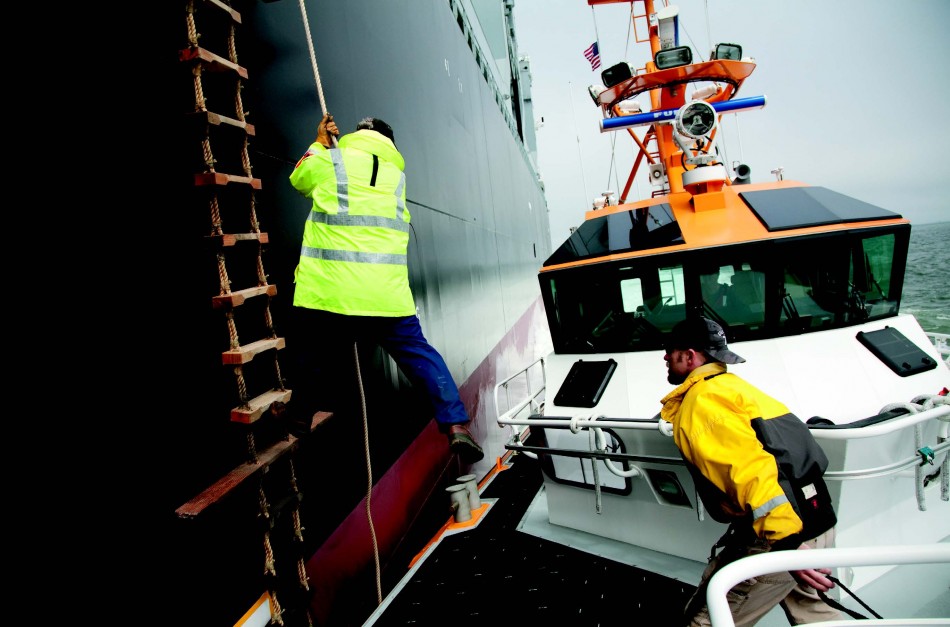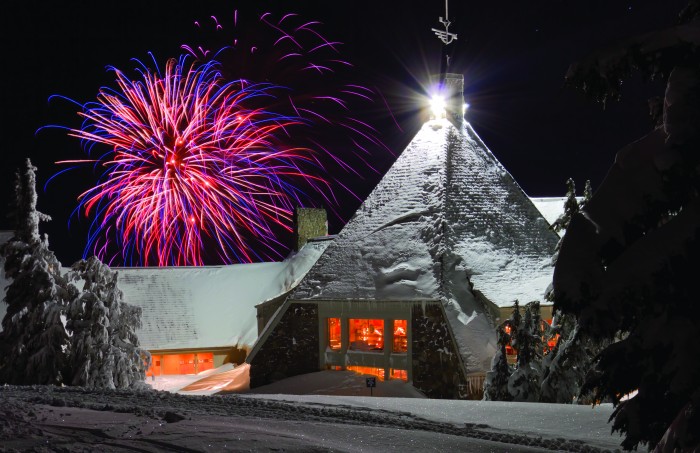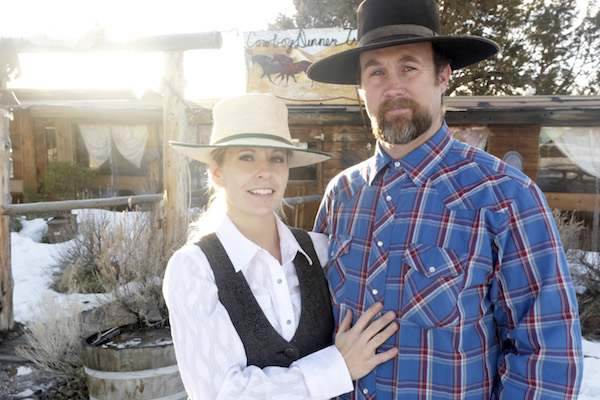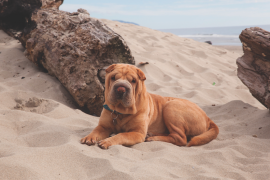It’s an hour before sunrise a few miles out in the Pacific Ocean, just west of Astoria. The water is uncharacteristically calm,and the Columbia, a $4.2 million 73-foot twin-engine jet boat, bobs up and down, waiting for its rendezvous with the Carl Oldendorff , a 563-foot cargo ship carrying 29,000 tons of grain en route to China.
This massive vessel pushed off from the Port of Vancouver, Washington the night before and, under the stewardship of a Columbia River Pilot, traveled nearly one hundred miles downriver to Astoria. Before the ship can get to the wide open waters of the ocean, however, it needs to slip through what salty ship captains consider the most dangerous stretch of
water in the world, the Columbia River Bar.
It is here in the jaws of the mighty Columbia River that water gushes more than a million cubic feet per second and smashes head on with hurricane-force winds creating twenty-, thirty-, sometimes forty-foot swells roaring off the Pacific. The collision between these two opposing forces is unnerving enough, but ship captains must also contend with submerged deposits of sand and silt that’s washed down river and piled up into ten- to fifteen-foot underwater speed bumps. These conditions not only threaten to rip ships into pieces, they force ocean swells to sheer off so that the back side is a freefall. Add pelting rain and heavy fog to the mix and the “Graveyard of the Pacific” has rightly earned its name.
About 2,000 vessels – 200 of them large ships – and more than 700 lives have been swallowed up by these waters since 1792, when explorer Robert Gray first gave the Columbia River her English name. In 1862, the adept U.S. Navy Commander Charles Wilkes leveled this warning after completing a four-year survey of the river: “Mere description can give but little idea of the terrors of the bar of the Columbia; all who have seen it have spoken of the wilderness of the ocean, and the incessant roar of the waters, representing it as one of the most fearful sights that can possibly meet the eye of the sailor.”
Yet, for the ships shuttling nearly 45 million tons and billions and billions of dollars in grain, fuel, cars and other goods to and from Portland, Vancouver and other inland ports each year, there’s no getting around this perilous passage. The demands of commerce clash mightily with Mother Nature.
For Columbia River Bar Pilots, a cadre of sixteen elite ship captains charged with shepherding ships over the Columbia River’s crux, this tempestuous relationship is a daily affair.
Graveyard is a fitting moniker this morning. Complete darkness – save for the blur of red and green lights fl ashing on nearby buoys – gives way to fog as thick as mashed potatoes. This eerie scene is made more eerie by the sudden appearance of the Carl Oldendorff in front of the Columbia. “Curt, I’ve got you spotted,” the Columbia’s operator, Allen Robitsch, says over his radio. He puts the throttle down. Deckhand Mike Hughes steps into a full harness and zips into his float coat. Robitsch powers straight toward the Carl Oldendorff ’s massive hull as if to broadside it. Then he takes a sharp left and gracefully pulls up within inches of the ship while matching its cruising speed knot for knot.
The intensity and concentration heighten as Hughes steps out onto the bow and clips into a safety line. He fixes his eyes on the rope-and-wood ladder that snakes up the side of the ship and disappears some thirty feet up. From this deck high above the Columbia, Capt. Curt Nehring emerges as a speckle of orange neon capped with a blue helmet.
A couple hours earlier, Nehring boarded the Carl Oldendorff near Tongue Point and took command from one of the Columbia River Pilots, a separate entity charged with piloting ships once they’re safely over the bar. For anyone who grew up hearing tales of overbearing ship captains, the notion that they would willfully relinquish control to strangers seems absurd. Yet, it’s customary to turn over the helm to local pilots when going in and out of unfamiliar ports. Such local expertise is particularly critical on the Columbia River, where foul weather is compounded by the channel’s narrow dimensions.
At its bottleneck, 600 feet in width and 43 feet in depth, the channel is about as wide as most ships are long and only a few feet deeper than the maximum draft, the clearance from the bottom of the hull to the riverbed. The Army Corps of Engineers routinely dredges the river from March to November to clear about 500,000 dump trucks worth of sand and silt from the channel, but the Columbia River continuously dumps in more.
When the weather is good, a one-way trip—which starts in the relatively calm waters near Astoria and goes out past the breakers— should take less than two hours. That same trip can take five hours under difficult conditions. “There are days when the wind and current are so strong, you’re just wishing the boat across the bar,” says Nehring.
The exact location of “the bar” depends on when the channel was last dredged and, of course, the weather. But the consensus among the bar pilots is that the worst of the channel starts near the Clatsop Spit and extends about three miles out to sea.
Fortunately, the Carl Oldendorff ’s outbound journey has been uneventful, save for a few kamikaze sport fishermen crossing its path, obliviously tempting fate. Now, with the bar safely in the ship’s wake, Nehring returns control of the vessel to his long-haul counterpart and prepares to climb down the rope-and-wood ladder, while the ship maintains twelve knots.
While a few of the ship’s crewmen watch, Nehring steps off the deck and expertly descends the primitive ladder, each hand gripping a manrope. With a few feet to go, he launches himself from the side of the ship and swings toward the deck of the Columbia, where Hughes grabs for his jacket. Feet firmly planted, Nehring waves goodbye to the crew of the Oldendorff as the Columbia pulls away.
Nehring joined the Columbia River Bar Pilots nearly six years ago and has done more than a 1,500 such transits. But with a long night of working ships behind him, he’s euphoric. “One of the bar pilots says we’re all adrenaline junkies,” says Nehring, 61. “That’s probably closer to the truth than most of us are willing to admit.”
Adrenaline junkies they may be, but reckless cowboys they are not. To become a bar pilot takes decades of experience at sea and a keen mastery that allows them to navigate a broad range of ships. Consequently, most Columbia River Bar Pilots are just settling into their jobs—dangling from helicopters and climbing the sides of ships—in their late fifties and early sixties while their peers are on golf courses contemplating retirement.
After graduation from the Maine Maritime Academy in 1971, Nehring worked his way up the ranks in the Navy and then captained tankers for twenty years before approaching the Columbia River Bar Pilots in 1999. Like many of his colleagues, he was weary of half-year stints at sea and wanted the relative predictability of a fixed location and fixed schedule. And while there are pilot jobs elsewhere, Nehring figured, “If you’re going to be a pilot, you might as well be the best of the best and pilot the Columbia River Bar.”
The Columbia River Bar Pilots trace their tradition back to Chinook Indians who helped sailors in early nineteenth century navigate the bar in exchange for blankets, axes and other goods. In 1846, the group was made official when Oregon’s provisional government established the Board of Maritime Pilots to oversee pilot licensing. In 1851, Capt. George Flavel raised the bar, so to speak, when he insisted that only ship masters need apply for positions as bar pilots.
Early bar pilots taxied out to ships on wooden boats powered by two brave oarsmen, making today’s conditions seem like a dinner cruise. In 1967, a new boat called the Peacock revolutionized bar piloting. The 89-foot self-righting vessel (which will soon be on permanent display outside the Columbia River Maritime Museum in Astoria) carried a twenty-three-foot “daughter boat” out to the ships. It was from this daughter boat that pilots actually embarked and disembarked. The Peacock was the workhorse of the bar pilots until 1999, when it was replaced by a helicopter and, later, the Chinook and Columbia, two multimillion-dollar “fast boats” decked out with the navigation systems of a modern airport control tower.
While technology has helped make these waters more navigable, it’s not a fail-safe—a point that became all too clear to Capt. John Torjusen who has had two ships lose power while in the throes of nasty seas. “All you can do is drop anchor and try not to hit anything,” Torjusen, 53, says. When everything goes to hell, human experience, not gadgetry, is the only thing that keeps ships from taking permanent residency in this nautical graveyard.
To be considered for a position, a prospective bar pilot needs a minimum of two years at sea as the captain of a commercial vessel greater than 5,000 tons, though most bar pilots have logged far more time than that. They then need to endure three days of tests, and are ranked by results. There are currently a dozen prospective pilots waiting in the wings for a position to open. The wait can take years.
If they’re called up to take the next step, the fun begins. These candidates must memorize and draw by memory every inch of the channel between the ocean buoy and Tongue Point seventeen miles upriver. Finally, they need to complete one hundred crossings of the bar with another pilot looking over his or—in the singular case of Capt. Debbie Dempsey—her shoulder. “When we go onto these ships we’re not carrying a chart,” says Dempsey. “It’s all in your head.”
Less than an hour after the Carl Oldendorff cleared the bar, Dempsey steers the Ken Ten, a 506-foot outbound ship bound for Japan, ninety degrees to block waves for the Columbia and prepares for her departure. The Philippines-based crew, including one wielding a camera, is particularly interested in documenting this exchange. Not only is the Columbia bar itself a legend, so too is 61-year-old Dempsey, who made international news in 1984 when she became the first woman to earn an unlimited masters license in the U.S. Merchant Marine.
Dempsey had to overcome more than her share of obstacles to break into the male-dominated shipping industry, but in 1994, her gender proved an asset. Th e Columbia River Bar Pilots were under pressure to add women and minorities to their ranks. Dempsey, who was a already a well-known entity, was recruited for the job. Of course, before she could make history again, she too would have to memorize the channel and make the requisite hundred trips over the bar.
As much as the Columbia River Bar Pilots act as maritime liaisons for international commerce, the organization is a private company with sixteen independent contractors—the bar pilots—who own shares in the organization. Th e group shares the expense of boats, boat operators, helicopters and support staff . They average ten crossings per day and collect $400 to $6,000 per transit, with fees regulated by the state. When pilots retire, they sell their shares back to the organization and incoming pilots buy in. In a good year, after the bills are paid, a bar pilot might make about $200,000.
Of course, when the economy is lean and the weather is mean, bar pilots might have second thoughts about their career choices. “When the winds blow out of the south, you just hate it,” says Dempsey, “because here it comes.” The job is physically and mentally demanding. Pilots typically work twenty days on and twenty days off , with shorter stints in the winter, when the weather is at its worst. During any given stretch, a bar pilot works as many as four ships and is then required to have nine hours off . Those hours fly by quickly, and rest doesn’t always come easy. “The stress is bad, particularly when the weather is bad,” says Capt. Gary Lewin, a bar pilot since 1983 who now manages the operation. “You go to bed and hear the wind and the rain—there’s no getting away from it.”
According to pilot lore, a captain visiting the Columbia bar from the Gulf Coast said, “Son, you work in weather we give names to down there.”
That stress is layered with responsibility. As independent contractors, the onus for getting a ship safely over the bar falls solely on their shoulders. Not far from the minds of every bar pilot is an incident that came in late 2007 in the San Francisco Bay. A bar pilot, who was relying on electronic charts and radar in heavy fog, steered a 900-foot container ship into the Bay Bridge. The ship spilled thousands of gallons of fuel into the water. If a pilot has a catastrophe such as that, says Lewin, that pilot is liable.
The Columbia bar pilots haven’t had a major incident with a ship in more than twenty years, but a tragic accident four years ago is a constant reminder of the occupational hazards. In January 2006, in forty- knot winds and nineteen-foot waves, Capt. Kevin Murray was disembarking a log ship. It was the 50-year-old’s first year as a bar pilot. His feet never made it to the deck of the Chinook as soaring waves swept him away. The Coast Guard and the bar pilots searched for days before the body was found on shore seventy-five miles north.
With the use of helicopters in the biggest waves, the risk of another bar pilot being swept out to sea has greatly diminished. Nevertheless as Dempsey prepares to jump from the 506-foot vessel to the Columbia the tension floats in steady swells. In these relatively calm seas in August, however, she alights without a hitch. From the bow of the Columbia, she quickly waves goodbye to the curious Ken Ten crew, who snap photos of the female pilot.
Having spent the better part of the night working ships in and out of the Columbia bar, Dempsey and Nehring are ready to sleep. In the evening, they’ll be back on duty, escorting islands of steel over the bar yet. The demands of commerce are constant. The job, however, is never routine. “Could I do this with my eyes closed?” Dempsey asks. “Never.”









